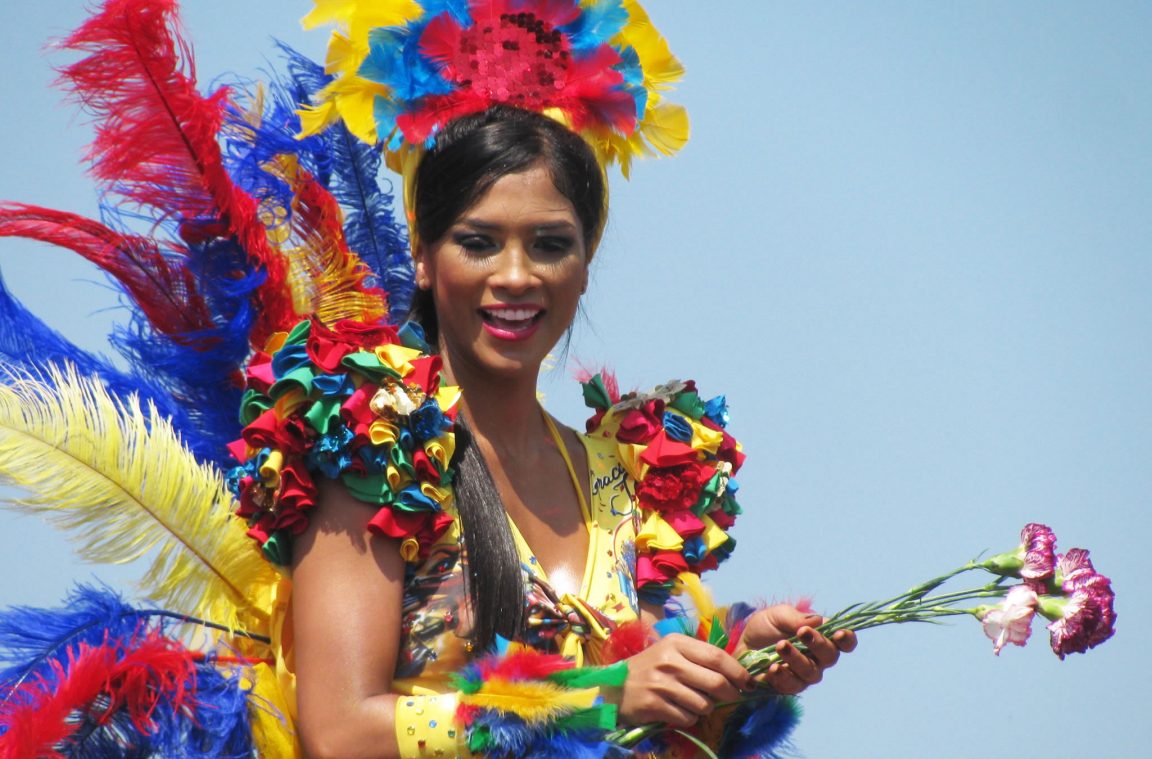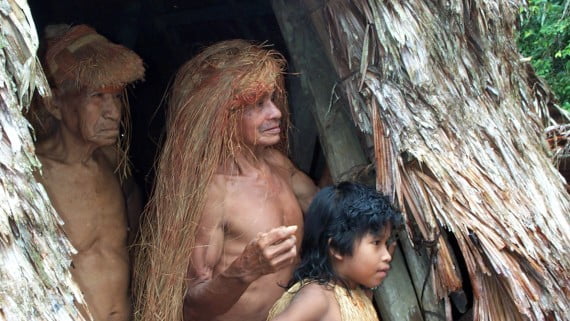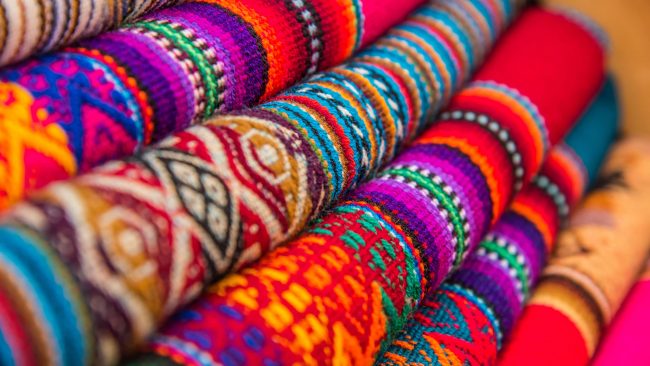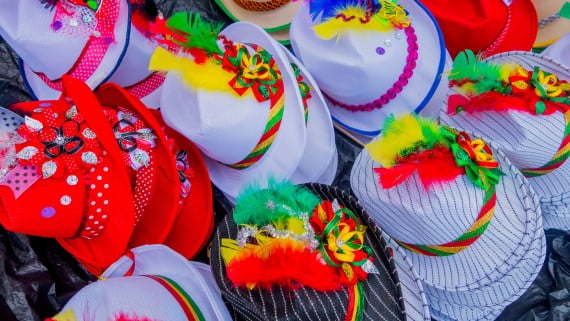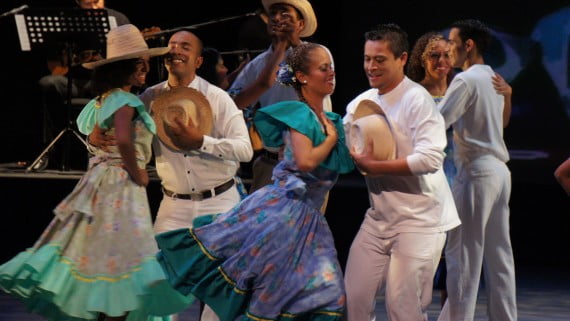Colombian folklore is a mix between the cultures of the South American indigenous communities, Spanish culture and imported African cultures during the colonial era. All of this can be observed if we analyze the typical costumes of each of the regions of Colombia, which we list below.
Below you have an index with all the points that we are going to deal with in this article.
Article Index
- 1.
- 1.1.
- 1.2.
- 2.
- 2.1.
- 2.2.
- 2.3.
- 3.
- 3.1.
- 3.2.
- 3.3.
- 4.
- 5.
- 6.
- 6.1.
Amazon region
The Amazon Region or, simply, Amazonia is the area that is in the south of the country. As a whole, it comprises 41% of the entire national territory, so it is the least populated region of all, although it has several departments: Amazonas, Caquetá, Guainía, Guaviare, Meta, Putumayo, Vaupés and Vichada.
Yagua town
Thus, for example, one of the ethnic groups with the largest number of inhabitants is the and water o nihamwo, which also has few populations in the Peruvian Amazon. This group is strongly rooted in its shamanistic beliefs and, therefore, they value above all harmony with nature, in addition to other aspects such as food and health.
They have numerous rituals for which a specific outfit is essential, although nevertheless their day-to-day clothing is handcrafted from palm fibers, different kinds of baskets and hammocks, both the female and the male costume.
Yapurutú Festivities
At a historical level, the inhabitants of the Department of La Guainía did not begin to wear clothes until about 1950; until then, they were naked or at most they used loincloth made from tree barkwhile the women had their entire torso exposed.
Today, however, the customs of the indigenous peoples have been modified. However, the ceremonial costumes of yesteryear are often used as a way to keep traditional memory alive. They are used especially at festive times, to practice the main dances, play music or carry out their own rituals, where mythology plays a quite relevant role.
The traditional costume of these indigenous groups for its rituals it is made of a fiber extracted from the bark of trees that grow in the Amazon. Once collected, the bark of the tree is molded and later the resulting costume is used, above all, for the Yapurutú festivities, typical of the Guarequena ethnic group, a demonstration of which can be seen in the following video:
https://www.youtube.com/watch?v=lyAK_rJVYqc
In addition, these costumes have several elements typical of ancestral symbols, such as vegetable paintings made with ink extracted from wild bushes. The use of a feathered crown is also common in the case of men, as well as painting their faces and sometimes their entire bodies, in the latter case drawing shapes that represent historical and cultural elements for their community.
Andean region
The Andes Mountains constitute a mountain chain located in South America that crosses several countries, including Chile, Peru, Bolivia, Ecuador, Colombia and Venezuela. It is a vast territory where the legacy of the Quechua ethnic group stands out, an indigenous town that inhabited this area in the era of the Anchaic Empire.
However, today there are still Quechua communities in this area. In Colombian territory, the highest concentration of inhabitants of this ethnic group inhabit the Andes of southern Colombia.
Thus, the language and, ultimately, the culture of the Quechuas has reached our days, something that has greatly marked the dances, music and, of course, the typical costumes of this Colombian region. The Andean region of Colombia is divided into a total of 13 departments: Antioquia, Caldas, Boyacá, Cauca, Cundinamarca, Nariño, Huila, Norte de Santander, Quindío, Risaralda, Tolima, Santander and Valle del Cauca.
Although typical costumes of the Andean Region of Colombia vary depending on each department, since each one of them has its own festivities, the truth is that there is a common garment: the so-called Ruane. It is a cape-like garment that closely resembles the typical poncho of the traditional mexican dress.
La Ruane It is made of wool and, to wear it correctly, it must be wrapped tightly around the shoulders. There is also the possibility of doing it around a single shoulder, while hanging slightly from the other. It is said that its origin dates back to the Muisca indigenous people, whose inhabitants used the so-called chibcha poncho, and also the classic Spanish cape.
Sanjuanero Huilense
The huilense sanjuanero or bambuco dance is a typical dance of the area that began to be practiced for the first time in 1961. Although both its male and female versions stand out, it is true that the female costume is the most striking and elaborate of all . It is basically made up of the following pieces: skirt with embroidered flowers, white blouse and golden sneakers.
The blouse, which must be white, is tight to the body and has a zipper at the back. The neck of this shirt is in the shape of a tray, so that the shoulders and neck are exposed, and it is usually adorned with white polyester lace. The following video shows us an example of what the dance of the sanjuanero from Huila is like:
https://www.youtube.com/watch?v=8DOOPFVZsEw
With regard to the skirt, as it has been seen in the video, it is a very elaborate garment if we opt for the version in which the flowers, of different sizes, are stamped in satin.
However, there are simpler versions in which the flowers (both leaves and buds) are simply painted on the fabric. There is no predetermined color for this garment, so the colors of this garment can vary and go from pink tones to more orange tones.
It is important to note that the way in which the flowers on the skirt are distributed is not random, but must follow a specific pattern: there must be five bouquets in the front and another five in the back. In each bouquet, there are up to three types of different sizes. Thus, the large bouquets include between 10 and 12 flowers, the medium ones 4-5 flowers and the smaller ones between 9 and 12.
Paisa hat
An indispensable accessory is the famous paisa hat or antioqueño hat, a garment that is traditionally manufactured in the Andean region of Colombia and that has become a regional symbol, especially in the departments of the Eje Cafetero and Antioquia.
One of the most striking characteristics of this garment is that there is no standard model, so while the older models had a very high cup, which today is highly appreciated by collectors, is no longer available today. manufactures this model, although some of the original features such as the very short or very wide brim are still preserved, and the base color is essentially white.
chapola
The character of the chapolera is also very popular, very representative throughout the Colombian Andean Region. This feminine suit consists of a huge black skirt that reaches up to 20 cm above the ankle and includes multicolored ribbons, accompanied by printed fabrics in a variety of colors.
Traditionally, the character of the chapolera is associated with values such as wealth and status, and is considered the best design of its time. The blouse that accompanies this skirt is always white with some ornaments (embroidery, lace, ruches, tucks ...), made of cotton fabric, high neck and usually short sleeves. Under the skirt, the chapolera wears one or even two boleros and always wears petticoats (women's underwear). As footwear, the chapolera wears espadrilles.
The history of the chapolera character goes back to the beginning of the XNUMXth century. He is a typical character of the coffee region who was formerly dedicated to the coffee picking. The chapoleras lived in the departments of Quindío, Caldas, Risaralda and some isolated municipalities in the North of Valle del Cauca. The name of chapolera comes from the term Chapora, which refers to a butterfly in the area that usually migrate to coffee farms at harvest time.
The Caribbean Region
The Caribbean Region of Colombia is the northernmost area of the country, whose name is due to the fact that it is surrounded by the Caribbean Sea to the north. Formed by nine departments, it is an area that has many customs, dances and musical styles.
Palenqueras
The term palenquero applies both to the inhabitants of San Basilio de Palenque (north coast of Colombia) and to the famous palenqueras, women who have become one of the most representative symbols not only of this community but of Colombia in general.
In this area, inhabited in its vast majority by descendants of slaves who arrived from Africa during the fifteenth century onwards, it is something of the day to day to meet women dressed in colored dresses or with the colors of the flag of Colombia, always carrying a basin full of fruits on the head.
Typical dances
In Palenque also, as we said at the beginning of this section, music is very present in the lives of its inhabitants. In fact, there are numerous music and dance schools throughout this area. However, the dance of bullerengue Colombian is possibly the most widespread dance in Palenque and Cartagena.
Others that have wide popularity are the son de negros, the son palenquero and the chulapa. These musical rhythms are characterized by being the result of a mix between African and Latin music, as well as by using typical instruments such as the drum, bongo, timba and bass drum, among others, for their composition.
Another of the typical dances of Cartagena de Indias that, of course, is accompanied by a typical costume is the colombian mapale, a dance that is also very reminiscent of the traditional rhythms of the African ethnicities. The traditional clothing for dancing the mapalé consists, above all, of simple garments for both men and women.
Thus, the men's suit includes long pants (up to the heels) that are adorned with fringes or washers. The woman, for her part, wears a more or less short skirt also adorned with fringes or ruffles to enhance the movement of her hips.
La cumbia It is also one of the quintessential dances of Colombia. In fact, there is a song called "La Pollera Colorá", considered by many to be the second national anthem of the country. To dance the cumbia, women wear wide skirts and two types of blouses: on the one hand, closed ones, with three-quarter sleeves with ruffles, and low-cut ones, which are usually used in areas with warmer climates. For men, the suit is totally white, with a round neck shirt and long closed cuff sleeves, as we will see in the following video:
El Colombian fandango It is another of the most striking dances in terms of costumes from the Caribbean region of Colombia. It is danced as a couple, so both men and women must wear a specific costume. The women's wardrobe consists of a camisole or short blouse, a wide and long skirt up to the ankle in a yoke cut or curled at the waist. In addition, it is adorned with braids, coverlets and other decorative elements. Footwear must be comfortable to facilitate dance movements.
Barranquilla
The typical clothing of Barranquilla is soft and fresh, as in most areas of the Colombian Caribbean Region. For the day to day, the men barraquilleros usually dress with fine fabric shirts and linen pants, very suitable for the hot climate of the area. But there is a garment that, like the paisa hat, is a symbol of Barranquila: it is the vueltiao hat, widely used by both men and women. Also, it is quite common to wear a scarf tied around the neck.
Probably, where the greatest amount of typical Colombian costumes can be seen is in the famous Carnival of Barranquilla, an event that is held annually and that today constitutes the most important folkloric festival in Colombia. In it, the objective is to represent all the cultural varieties of the Colombian Caribbean coast, so that the dances, costumes and musical rhythms of the region can be seen and heard in it. It has several typical costumes, such as Marimonda or Garabato.
El vueltiao hat It is especially popular in Córdoba, Bolívar and Sucre, and has become one of the main pieces of handicrafts from Colombia. Actually, this hat owes its origin to the indigenous community Zenú, which inhabits the Sinú River region. Specifically, the municipality of Tuchín is considered to be the birthplace of the vueltiao hat, which is made with arrow cane leaves, that is, a species of grass native to the region. Since 2004, the vueltiao hat is a Cultural Symbol of the Nation. This hat is made up of the following parts:
- Template: the making of this hat begins with this horizontal part that crowns the hat.
- Being: also called first round o hat ring, is the central part of the template.
- Cup or coating: it is made up of five braids, the first four painted and the last white.
- Wing: XNUMX laps on average, it is the last step in the process of making the vueltiao hat. It begins with a black braid and then alternates with other colored ones. The last lap is known as last lap.
Island region
The Insular Region is the set of marine islands belonging to Colombia that are far from the continental coasts. It is made up of San Andrés and Providencia, Bolívar (Rosario Islands and San Bernardo Islands), Cauca (Gorgona Island) and Valle del Cauca (Malpelo Island).
Despite the small area that this region of Colombia covers, it is a very culturally diverse part of the country in which typical costumes are defined by its dry climate and defined periods of rain.
The quintessential clothing of the Insular Region for women consists of a a white blouse long sleeves and high neck, combined with a long skirt that usually reaches to the ankles. In addition, accessories such as a head scarf in a bright color are usually added to this suit.
As for the men's suit, it also consists mainly of a shirt, almost always white. The pants are usually gray, although they can also be seen in cream, or even black, always combined with black shoes.
However, the traditional costumes of this area are those associated with its popular dances, such as the waltz, the aisle, the mazurka, the polka, the vallenato dance, the calipzo, the mentó, the yaya yaga, etc. In the following video we can see a representation of the famous hall dance:
Orinoquía region
The Orinoquia Region, known as Orinoquia without more, is located in the eastern part of the country and is also known as Eastern plains, for which the inhabitants are called llaneros and llaneras. The region is made up of the following departments: Arauca, Casanare, Guaviare, Meta and Vichada. The meaning of their typical costumes lies in the culture of the llaneros, who define themselves as workers, dedicated to raising cattle.
For this reason, in this area, the typical costumes for both men and women are based on providing the maximum possible comfort when working. Thus, the men's suit, called liquiliqui, It is a simple, fresh and above all light costume, although at present it is only used in social events, festive periods and for the dance of the joropo, that is, the traditional llanera dance. It consists of pants, jacket and espadrilles that can be found either in white or in bright colors.
The traditional feminine dress consists of a wide flared skirt that reaches to the ankle. For its preparation, up to seven rods of fabric are spent with which they can be of light colors or red or even printed with flowers.
As in other typical costumes, a petticoat and wide combination is used. The blouse has a high neck, three-quarter sleeves and is usually adorned with ribbons and buttons at the back. This is the traditional dress, although today wide blouses with neckline and short sleeves are also used. In hair, loose hair with a cayenne flower as decoration.
Pacific region
The Pacific Region of Colombia is made up of the cities of Tumaco, Quibdó, Chocó and Buenaventura. In this region, various black communities coexist that even today preserve their original traditions from Africa, such as the way of dressing and traditional dances, intact. Even in gastronomy, typical cultural traits of Afro-descendants can be observed.
The typical costumes of this area, where the inhabitants are mostly from humble classThey are therefore simple and, above all, made of soft and fine fabrics suitable for withstanding high temperatures.
Typical dances
One of the dances par excellence of the Pacific Region of Colombia is the curriculum. This native musical rhythm of this Colombian region has crossed borders and several versions can be observed in different Ecuadorian regions.
Also know as old bambuco, the currulao is a dance traditionally oriented towards courtship and is closely related to the Afro-descendant culture of the region. It is a dance for which all the details must be taken care of to the smallest detail, both in the feminine and in the masculine attire. Let's see in the following video what are the suits for both sexes:
To dance another dance of Spanish origin known as la Colombian jota, a dance that the Spanish colonizers brought to the area several centuries ago, the women's costume, for its part, is usually white, although it is also found in various colors such as pink or yellow. Although simplicity prevails, some women prefer to adorn it with colored ribbons, embroidery or ruffles.
This article has been shared 197 times. We have spent many hours collecting this information. If you liked it, share it, please:
